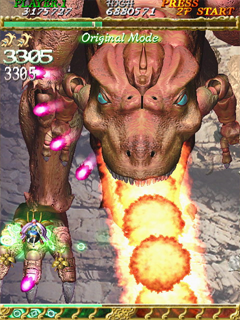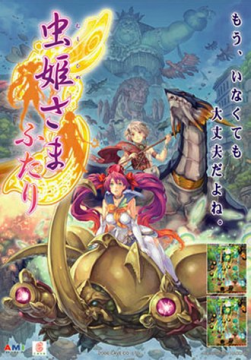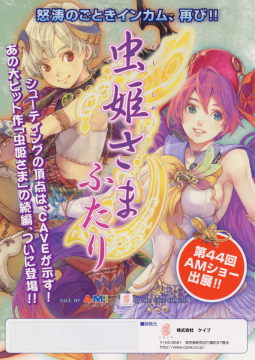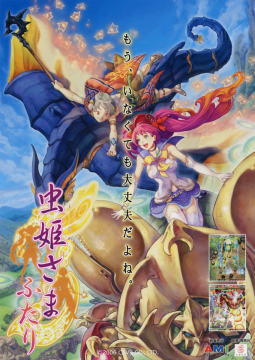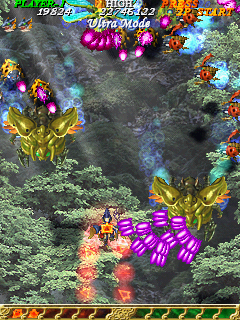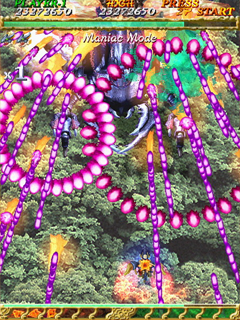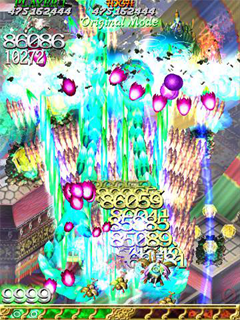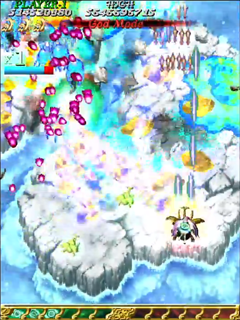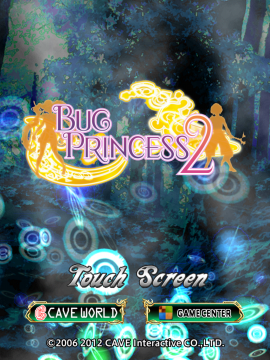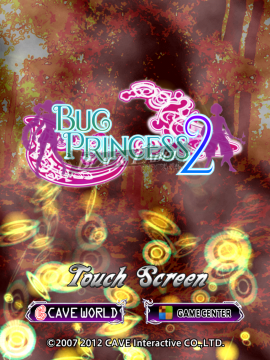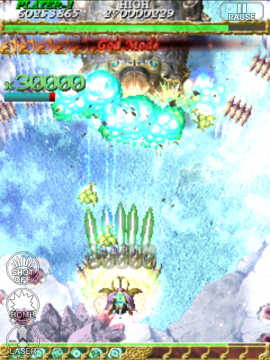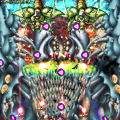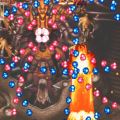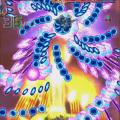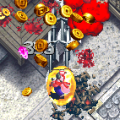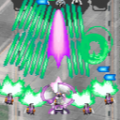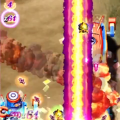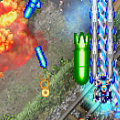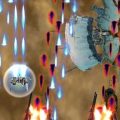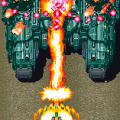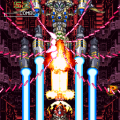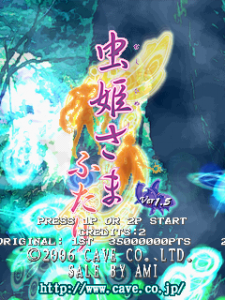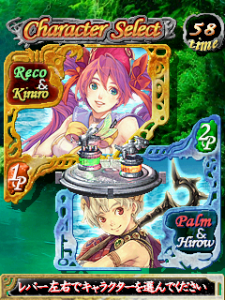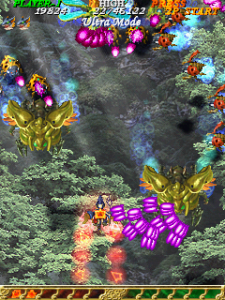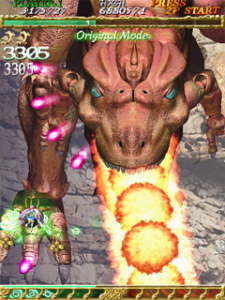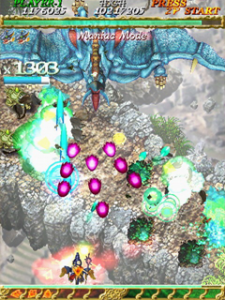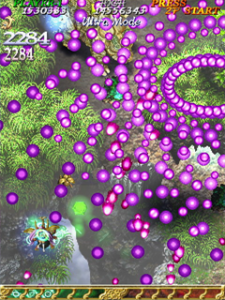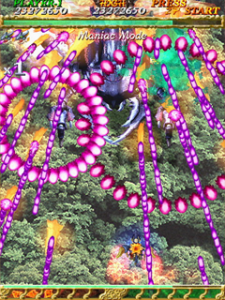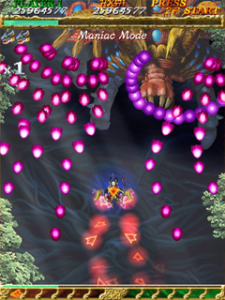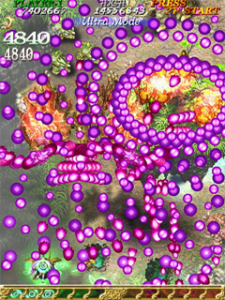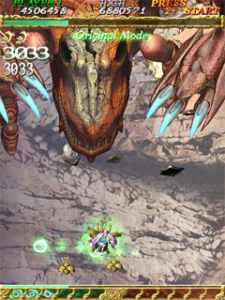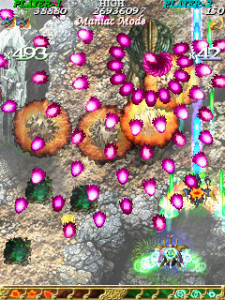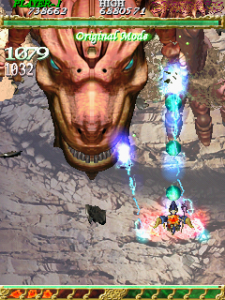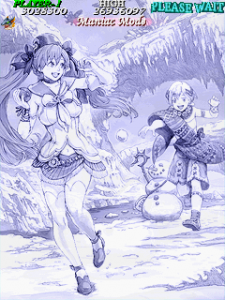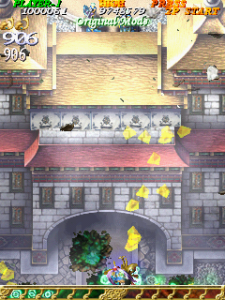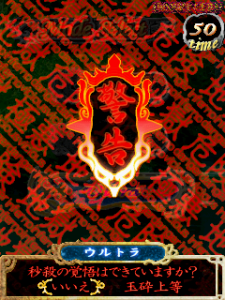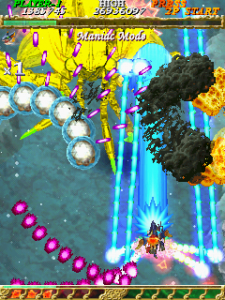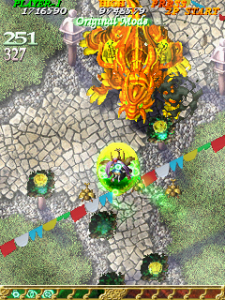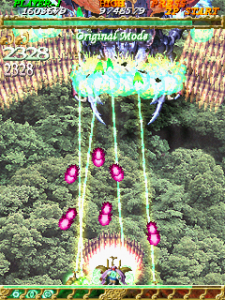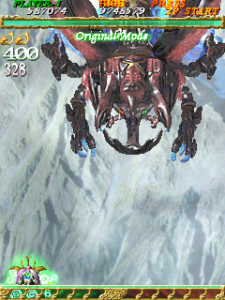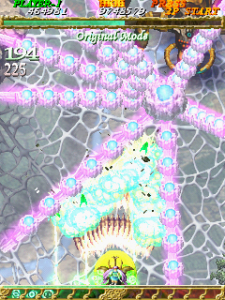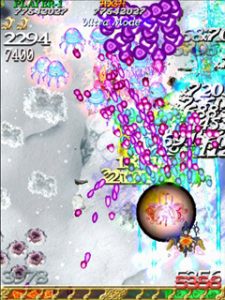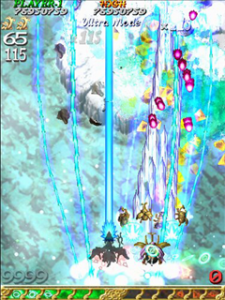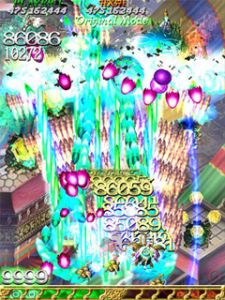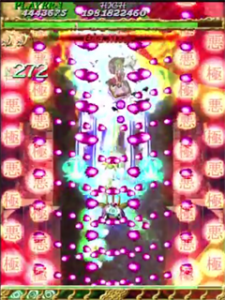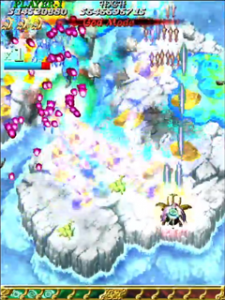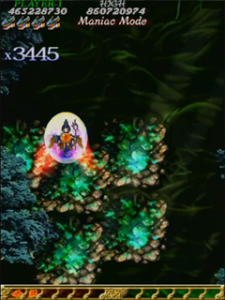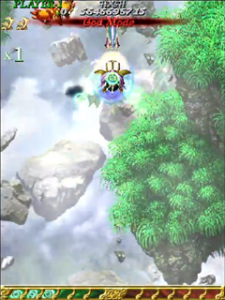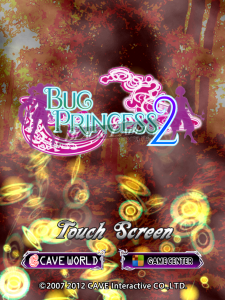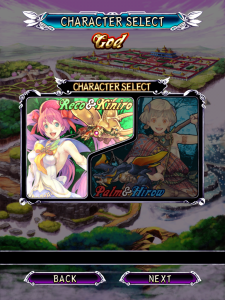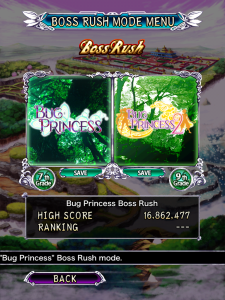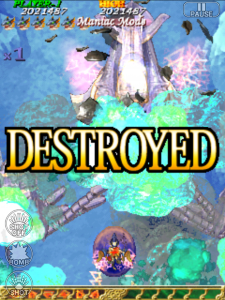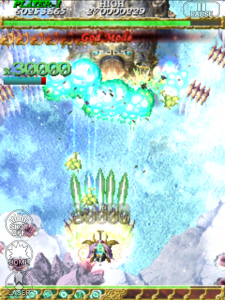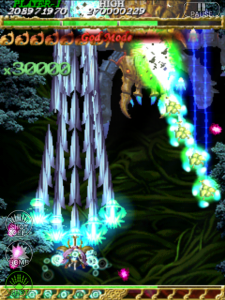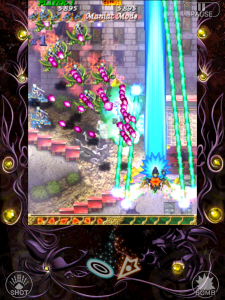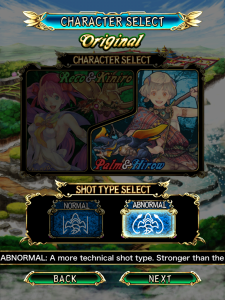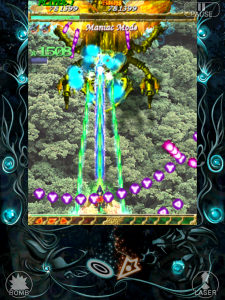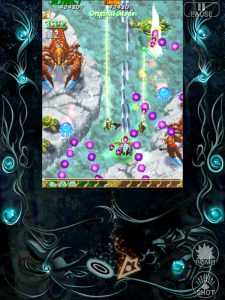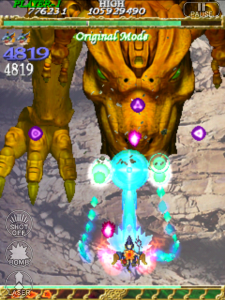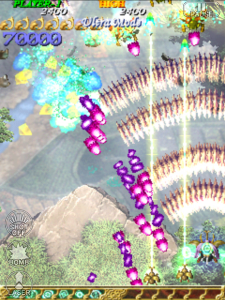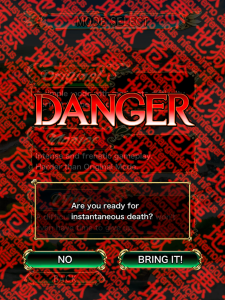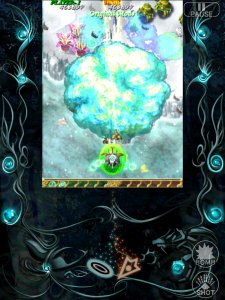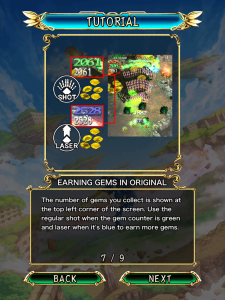- Mushihime-sama
- Mushihime-sama Futari
- Puzzle! Mushihime-tama
- Mushihime-sama Bug Panic
On October 27, 2006 Cave released a sequel to their 2004 release Mushihime-sama called Mushihime-sama Futari, with Futari being a pun on the Japanese word for “two” when counting people. The game starts out with your character piercing through the clouds, providing a good sense of wonder for the grand adventure you’re about to embark on. But it’s not until the player reach the end of the first stage, when suddenly the screen is scrolling in reverse and the aptly titled “Beastial Beat” boss music kicks in. That’s when you realize that an enormous T-Rex has busted through the cliffs and is now chasing you as you flee for dear life. Also, the T-Rex is also spitting out fireballs and bullets. Mushihime-sama Futariwastes little time notifying the player that they are in for one hell of a ride.
Story
Mushihime-sama ends with Princess Reco defeating Aki, the God of Koju. After his defeat, Aki explains that he had traveled to Shinju Forest many years ago to prevent the Koju from harming humans anymore. However, his power had reached its limits, and he was not long for this world. Thus, he asks Reco to take his place as God of Koju. There would be no return to her village. An awesome responsibility had been charged to her: to hold back the Koju and protect humankind. Sometime after, during one of her usual walks through the forest she finds a young boy, collapsed alongside his companion, a large dragon-like dinosaur. Awaking the boy, Reco introduced herself as the goddess of Shinju Forest. The boy, who introduced himself as Palm, told Reco that he needed to return to his home of Utakata Village, which is currently under assault by Koju. While this story was true, the boy did not tell Reco the real reason for their journey. Palm had been manipulated into bringing Reco back to his Mother, the arrogant Queen Larsa. Queen Larsa believes that Reco had mercilessly killed not only her heir, but her favorite Prince, Aki. Thus, Reco and Palm set off to Utakata Village, where an angry and revengeful Queen Larsa prepares for their arrival.
Characters
Reco
The current Goddess of Shinju Forest. She rides a Rhinocerous bettle Koju named Kiniro. The Burst Seeds she uses have a purification effect that boosts their power.
Kiniro
A three-horned Rhinoceros Beetle Koju who has befriended Reco. Commands the smaller beetle Koju accompanying him. Kiniro doesn’t get along with a Koju of the same type called “Kurogane”.
Palm
The 9-year-old younger brother of Aki, the once god of the forest, and son to Queen Larsa of Utakata palace. An innocent and pure child, Palm set off on his dragon, Hirow, to find Reco and ultimately bring her back to his Mother.
Hirow
A dragon-type dinosaur who has known Palm since he was young. With the power of Palm’s staff, Hirow can breathe fireballs that knock enemies out of the sky.
Princess Reco and her companion Kiniro return as playable characters in Mushihime-sama Futari, with Prince Palm and his companion Hirow joining them as playable characters. Gone are the shot types from Mushihime-sama, instead, both characters have a “Normal” and “Abnormal” version to select with their own pre-defined shot and laser types. The Normal version of Reco acts very similar to how she did in the prequel, and is the best well-rounded character in Futari. Holding down the A shot will slow her movement speed and change to something similar to the S-Power shot type, with any options forming up in front of her. Where her regular shot acts like the W-Power shot type, with her options spreading out on both sides of Reco. The Abnormal version of Reco, Abnormal Reco, lacks a traditional laser beam; instead using the S-Power shot type from the first game. Her real power when using her laser come from her child pods, which attach to the nearest enemy while the A button is held. Interestingly, the child pods act very similar to how they did in Ketsui, another Cave shmup. Abnormal Reco is also the hardest character to play in the game, having both the fastest and slowest movement speeds in the game. Her movement speeds are also opposite of the shmup conventions, possessing a very slow movement speed when using her shots, and a ridiculously fast movement speed when using her laser.
The Normal version of Palm is a decent character. While his laser is only moderately powerful, it can be quite effective. His shot is similar to the M-Power shot type from the first game, and is a good all-around character when fully powered up. The fourth playable character-type is Abnormal Palm. Abnormal Palm’s laser causes Hirow to shoot fireballs out in front of him with his options shooting lighting in an arc, and is pretty strong overall. To balance this out, Abnormal Palm’s regular shot is quite weak in both strength and range, despite how cool it looks moving around when maxed out. His move speed is also a tad on the slow side.
Gameplay Modes And Scoring
Also returning are the three mode types, Original, Maniac, and an Ultra mode, which would similarly be unlocked after certain conditions were met. In Futari, Original mode is characterized by having faster bullets, but less dense bullet patterns. Scoring in the original mode is based around two different counters located in the top-left corner of the screen: the larger counter is overall counter, and the smaller one beneath it is the stage counter. The overall counter’s value increases and persists throughout with no reachable maximum. The overall counter will also change color from green to blue depending on the value of the hundreds digit. From 0 to 499, the overall counter will be green, and enemies will spawn more gems if killed with the regular C shot in this phase. When its value is 500 to 999, the counter will turn blue, and defeating enemies with the laser will cause extra gems to appear. So this will create an almost rhythmic switching back and forth between the shot and the laser to properly increase the overall counter for scoring. The other counter, the stage counter resets at the beginning of each stage, and caps out at 9,999. Note that dying will cause the overall counter to decrease by a whopping 50%, and the stage counter 30%. Maniac mode has slower bullets than Original mode, but far denser bullet patterns. Maniac is also known for having most complex scoring system in the game.
Maniac mode scoring is based on a single counter known as the overall counter, which can only be triggered by killing enemies with the laser when the chaining bar is at zero. Then, each gem absorbed at this time will have a blue-aura, with the value of the multiplier added to the value of each of these gems. Unlike the overall counter in Original mode, this counter acts more like stage counter, resetting every stage, and has a maximum value of 9,999. Unique to Maniac mode is that when an enemy is destroyed, their bullets are changed into blue-aura gems, with additional gems being spawned from the enemy itself. Note that each blue-aura gem causes the overall counter to decrease, so plan carefully to get the maximum amount of large gems at a high multiplier! The final mode, Ultra, is known for having bullets faster than Original mode, and bullet patterns far more dense than in Maniac. Also returning is the warning when selecting it, this time taking a more realistic approach by asking, “Are you ready to be murdered every second?” Fret not, as when in Ultra mode the player’s hit box is reduced from a 4 pixel x 4 pixel box to a 4 pixel by 2 pixel box. It may not sound like much, but it is literally the difference between life and death in this hellish mode. Strangely, the scoring system in Ultra mode is the same as in the Original mode, rather than Maniac mode like in the first game. Exclusive to Ultra mode, is the game’s TLB (true last boss), containing not just one, but two life bars.
Music
The music in Mushihime-sama Futari is quite good, being a huge a step up from the first game. Composed by Manabu Namiki and Kimihiro Abe, the music regains the techno heavy flavors that just go so well with shmups, while also continuing to retain the natural and wondrous feeling that the first game’s music had. A great example of this would be the stage 3 music, “Is Shinju in the Forest Rebel Army?” As the player progresses further into the stage, they discover more and more enemies to an almost overwhelming amount. This feeling is expertly matched with the many different layers of instruments that are used throughout this track. The character selection music, “The Prince, Age 9” and boss music “Beastial Beat” really stand out as great tracks. A rather interesting track is the stage 5 music “On The Verge of Madness”, an eccentric fusion of classic Japanese music with the driving force of electro.
Issues
Sadly, the first release of Mushihime-sama Futari was not without its problems. The game suffered from brutally challenging gameplay, harshly unforgiving scoring systems, glitches and design oversights. One such oversight is that despite having a total of six bomb slots, it is only possible to get a maximum of five bombs in the game! Many players also felt that the bullets in all modes were just too fast, making the difficult stage 3 becomes nearly impossible for many players.
Most of the hardcore shmup players tend to look at these games as a puzzle, trying to figure out the best strategy to maximize their high scores. In that regard, players complained that the scoring systems felt too restrictive, especially the Maniac, where the multiplier only became worthwhile to use on the boss at the end of the stage. Mushihime-sama Futarialso had some glitches, with various effects such as causing some bosses to throw out undodgeable bullet patterns, or properly displaying the high scores table, and balancing issues, as some characters couldn’t do enough damage to kill the mid bosses, forcing them to bomb through the end or lose a life. Many players found this incredibly frustrating. The game had great art direction, wonderful music, and the overwhelming challenge that Cave shmups provide, but the game just wasn’t there. Mushihime-sama Futari had incredible potential, but it clearly needed to be tweaked and modified for it to be the game that both the Cave, and the players, wanted it to be.
Links:
Original mode gameplay Mushihime-sama Futari 1.0 1CC on Youtube
Mushihimesama Futari OST Playlist on Youtube
Mushihime-sama Futari Ver. 1.5 (虫姫さまふたり Ver 1.5) – Arcade, Xbox 360 (December, 2006)
Arcade Version 1.5
Players simply weren’t satisfied with Mushihime-sama Futari. They knew the game had potential, but its problems were just too numerous, preventing it from becoming something truly great. If these issues were addressed, perhaps Mushihime-sama Futari could be more than just a pretty face; and instead be an incredible game that people would not want to stop playing. Thankfully, Cave felt the same. And so, on December 18, 2006 (less than two months since Mushihime-sama Futari Ver. 1.5‘s release), Cave responded to their fans with an updated version of the game titled Mushihime-sama Futari Ver. 1.5. This aptly titled update had so many tweaks and fixes, it really was like a new version of Mushihime-sama Futari, and provided a slew of updates, both of the obvious, and of the subtle, to nearly every aspect of the game. This version had Ultra mode unlocked from the start, balanced out the characters to make them more usable, altered enemy placement and shot patterns, and outright removed some enemies. Additionally, many of the bosses would return with either modified or new bullet patterns. The life bars for the bosses now have marks indicating what point each phase is at. Ver 1.5 also played host to quite a number of tweaks for the three scoring modes, resulting in a smoother, more satisfying experience.
In Mushihime-sama Futari, certain characters just could not get through sections of the game without bombing or dying, while others were just a little bit too strong, resulting in those characters to be changed. In this new version, Normal Reco is slightly stronger overall, and Abnormal Reco is seemingly unchanged. Normal Palm actually received a nerf, becoming weaker than his 1.0 counterpart. Where in Mushihime-sama Futari Ver. 1.5 Abnormal Palm has been buffed, with a faster movement speed and the strongest laser in the game, making him the go to character for quickly dispatching bosses.
Gameplay Modes And Scoring
Gameplay-wise, the most noticeable change is that the bullet speed has been decreased for the first three stages, and has been increased for the final stage, providing smoother difficulty progression throughout the game. Cave also addressed the issues with bombs, having them do noticeably more damage and providing more bomb-dispensing enemies to the game. While many of the glitches in Mushihime-sama Futari Ver. 1.0 are gone, a few glitches still remain, such as having to kill the stage 3 boss and the stage 4 mid boss with the shot to have them spawn large gems, rather than the appropriate overall counter’s (now flashing) color dictates.
Scoring is much easier in Mushihime-sama Futari Ver. 1.5, with the values of all gems being increased for all modes. Other tweaks, such as the penalty for dying only removing one-third of the multiplier counters, and hidden mechanics such as destroying all of the lanterns in the fifth stage giving a substantial score bonus, lead to higher scores in all modes. One of the more subtle, and more important enhancements in Mushihime-sama Futari Ver. 1.5 is the “green-aura” gems that appear for a split second after an enemy is killed with the appropriate shot (based on the overall counter) before reverting back to regular gold gems. These green-aura gems now give double the point value as their golden counterparts do. Because of this change, the green-aura gems are now the secret to achieving high scores in both Original and Ultra modes. Because of their increased value in Mushihime-sama Futari Ver. 1.5, the player now has the ability to suck up ground gems when using the laser (the player sucks in airborne gems when not).
Not to be left out, each mode in Mushihime-sama Futari Ver. 1.5 saw various tweaks and balancing adjustments as well. The biggest change to Original mode arrives via the new rank system. The rank system is used to determine the player’s skill level, and adjusts bullet speed and density accordingly. This is determined by the number of the overall counter in the top left corner; the higher the counter, the harder the game becomes. The highest rank activates when the counter is at or higher than 70,000. At that point, the bullets have a sudden jump in speed, traveling as fast as in Ultra mode! Speaking of, the only important change to Ultra mode is that the overall counter now changes color every 2,000 points. The counter still changes color every 500 points in Original mode.
Maniac Mode
Players complained that the original system for Maniac was very restrictive and rather boring to play. A common complaint from Ver. 1.0 was that maxing out the multiplier counter took too long, resulting in very little incentive to cash in outside of the boss at the end of the stage. Cave went about fixing both of these issues with a few system tweaks and balancing. Thanks to the increased gem values, the overall counter is much easier to max out, allowing for multiple cash-ins throughout a stage and even boss fights (most notable on stage 2). Pushing it even further, destroying an enemy with the laser while chaining bar is flashing red will cause twice the normal amount of large gems to spawn; a nice reward that also cause the multiplier to increase at much faster pace. These changes come as a double-edged sword, since consequently; the multiplier now decreases at a much faster pace, thanks to the very same alterations. Overall, this produces a much looser, hectic and faster paced scoring system that better demonstrates its “Maniac” moniker.
Miraculously, Mushihime-sama Futari Ver. 1.5 managed to fix the problems many fans found with the original version. Therefore, it should be no surprise that the updated PCB’s quickly replaced the original game throughout Japan, becoming the definitive version of the game. It is nothing short of impressive that in a little under two months, Cave managed to take a rather disappointing game and change it to such a finely tuned, balanced, and most importantly, fun game to play and enjoy.
Xbox 360 Version
On November 26, 2009, Cave released a port of Mushihime-sama Futari Ver. 1.5 for the Xbox 360. The port contains two versions of Mushihime-sama Futari Ver. 1.5, one using the original arcade graphics, and the other “Xbox 360” mode that uses the new HD graphics. The game also included two brand new gameplay modes: Arrange mode and Novice mode. Cave also released a limited edition version of the game, containing different box artwork, the game’s OST, and a download code for an additional gameplay mode.
Although each mode contains its own set of tweaks, the menus and options remain constant for each game. In all games, players can choose from a Score Attack or Normal mode, go through a nice training mode, view online leaderboards and replays, adjust game-specific options, and return to the main title select. In Score Attack mode, the players are tasked with playing through the entire game on a single credit, with no continues. Regardless if the player is able to do achieve this, they are able to save a replay of their run to a local storage device, and even post their score to the global leaderboards on Xbox Live. Each game mode has its own leaderboard, accessed via a menu option in the score attack menu that has filters for every combination of mode, character, and character type, with the added bonus of being able to download and watch replays of the top players’ high scoring runs! The Normal mode option is just like score attack, but with the option to continue, and inability to record high scores to the online leaderboards. And if you are having some trouble clearing the game (that brutal stage 3 perhaps?) a training mode is available, with a nice selection of mode-specific options to recreate almost any condition you might encounter for that mode. Lastly, the training mode allows players to start at either the start of a stage, or at the boss of that stage.
Few games have as many screen options as Mushihime-sama Futari Ver. 1.5. Granting players the ability to adjust the screen rotation, aspect ratio, background wallpaper, zoom and position, for the main game screen, and up to four extra, independently configurable, screens called “ExtraViews.” To demonstrate what is possible with the ExtraViews, Cave has graciously provided a number of preset options. One option creates ExtraViews that enlarge the score display and the number of bombs in the players stock. Another preset creates a total of 5 screens horizontally, with a brief delay on each of them. Each of these additional windows are also customizable with various graphical filters and refresh options. Players can also set it so that every screen is set it to default tate mode, and certain options for all games. While this level of customization is certainly overkill, it’s a really shows far Cave is willing to go so that everyone can get the maximum enjoyment from their games.
Exclusive Xbox 360 Modes
Even though Cave had made the 1.5 revision easier than its predecessor, that doesn’t mean it’s an easy game to beat. Due to (bullet hell) shmups becoming an increasingly niche market because of their hefty challenge, Cave decided to try and expand their audience by creating a “Novice” mode. The goal of Novice mode was to allow more players to experience the joy from triumphing over a difficult challenge on a single credit. Novice mode is the same game as the Xbox 360 version, just with easier bullet patterns, and fewer bullets overall.
While watching the Neon Genesis Evangelion 1.0: You Are (Not) Alone movie, Cave’s CCO Tsuneki Ikeda wondered if he could make a gameplay system based around a scene in the movie. The scene he refers to occurs near the end of the movie, where Rei Ayanami protects Shinji Ikari from an otherwise fatal counter-attack by acting as his shield. Ikeda wondered if he could make a defensive system that could produce similarly heart-racing moments like that scene. While he felt that the excitement was ultimately lacking, the mode was ultimately left in as “Arrange” mode.
Based on the scoring system of Maniac, Arrange mode allows players to choose from the normal Original, Maniac, or Ultra modes, as well as their starting offensive character. In one player only mode, players control both Reco and Palm, armed with a combination of their normal and abnormal shot types. The other character plays a defensive role, forming a barrier around the player. If the player is using the regular shot, enemy bullets within that barrier will slow down, and pressing laser will cause any slowed bullets to be reflected back, leaving a trail of small airborne gems. This leads into the main mechanic of this mode, the two four-digit numbers on the bottom left and right side of the screen. These counters are attached to each character depending on the starting offensive choice. Collecting gems as the offensive character will cause their counter to increase. On the defensive side, players will gradually increase their counter by slowing bullets. If a bullet hits the defensive character or they reflect bullets, their counter will decrease, and should the defensive counter be zero, players cannot cause any bullets to slow down. Players can counter this by freely switching the offensive and defensive characters (and their positions) with the push of a button. The goal of this constant offensive and defensive switching is to get both character’s counters to their max of 9999, whereby pressing both shot and laser they enter into a “fever” mode. Fever mode is a timed mode ending when both counters tick down to zero. During that time, the player becomes much more powerful, and all gems gain a blue-aura, and greatly increase the players score. Arrange mode also has an auto-bomb feature, triggered by having the offensive character getting hit will cause them to throw one bomb. Because of this, the player essentially starts out with 18 lives, with each bomb powerup acting as yet another life. Due to the auto-bomb mechanic, the bullet reflecting system, and playing as both characters at once, Arrange mode is noticeably easier than the normal version of the game, but still a fun mode overall.
In an effort to increase initial sales, Cave added a rather interesting additional mode via DLC voucher to the first-print and limited editions of the game. Originally debuting at a Cave Matsuri (festival) in 2006, Mushihime-sama Futari Ver. 1.01 is what happens if the scoring systems of Mushihime-sama Futari Ver. 1.5 were placed top of the gameplay and difficulty of the original Mushihime-sama Futari, with the 1.5 fixes such as the extra bomb carriers. The result is a game that is harder, faster, and unbalanced than its later release. This version of the game was given away on a free DLC voucher included in first print editions of the game. As of time of this writing, no other ways to acquire this version of the game exist.
On December 11, 2009 Cave released another piece of DLC (this time available for everyone to enjoy) for the Xbox 360 port of Mushihime-sama Futari Ver. 1.5. This DLC was for the incredibly rare “Black Label” version of Mushihime-sama Futari Ver. 1.5, which will described in its own section later. Note, that while available in all regions of the Xbox 360 Marketplace for 1200 MS points, it is under the erroneous title of Mushihime-sama Hutari Black Lavel.
Thoughts On The Xbox 360 Port
This version would prove to be a very faithful port, having no missing slowdown from the arcade version, instead only having a few spots where slowdown was added in. Sadly, this port does suffer from some occasional graphical glitches in the Xbox 360 mode, but nothing game-breaking. Arguably the most important aspect of this port is that all versions are region-free, allowing it to be played on NTSC and PAL Xbox 360’s without any sort of modifications. And thanks to the ability to easily get the Black Label DLC regardless of region, this is one of the most complete, and most accessible shmup ports out there. It comes highly recommended.
Links:
Forum post citing the differences between 1.0 and 1.5
Overview of 1.5 modes and scoring
THE HARDEST VIDEO GAME BOSS EVER! The infamous video of the with over 4 million views
STG Weekly #2 A highly insightful look at Original mode, contains NSFW language
STG Weekly #8 A highly insightful look at two Ultra mode replays, contains NSFW language
Mushihimesama Futari Ver. 1.5 Black Label (虫姫さまふたり Ver.1.5 ブラックレーベル) – Arcade, Xbox 360 (December 20, 2007)
Did you know that Mushihime-sama Futari was originally planned to have four modes instead of the three it shipped with? This fourth mode, titled “God mode” would be added in a special remixed version of the game titled Mushihime-sama Futari Ver. 1.5 Black Label. This version was originally released for arcades on December 20, 2007, and was only available through Cave’s online store. Only 150 copies were produced, and were completely sold out within an hour. The game was originally completed in one month by a single programmer; Cave’s arcade publisher AMI wanted more content than a single mode and new TLB (Spiritual Larsa). This request saw Cave take their first foray into Adobe Photoshop, heavily modifying the background colors (most noticeable on stages 2, 3, and 5), along with remixed scoring systems and enemy placements. Similar to the Arrange mode on the Xbox 360 port of Mushihime-sama Futari Ver. 1.5, each character has only one shot type, a combination of the normal and abnormal types from the original game; and when combined with faster movement speed, the result is characters far more powerful than their original counterparts. Of course, this buff comes at the expense of all modes now having an increase in bullets that also travel faster. The bombing penalties were also harsher than in Mushihime-sama Futari Ver. 1.0, with a remixed end of game clear bonus calculation, awarding zero points if the player has 0 bombs in stock.
Scoring Differences
Mushihime-sama Futari Ver. 1.5 Black Label further refines the Original mode’sscoring system. In this version, the overall counter changes every 3,000 points, and plays an audible chime when changing. Enemies also spawn more gems, noted by a blue-aura, when they are killed at close range, with the medium and large sized enemies “shedding” small gems before they die. Maxing at the stage counter at 9999 produces all of those shedded gems to become large gems, making it the key for scoring in this mode! Also making a return is the rank system from 1.5, and it is back with a vengeance. While maxing out the stage counter is key to scoring, doing so will also cause the rank to skyrocket in difficulty, with bullets traveling much faster. This effect is compounded on top of the default speed increases that go with a high overall counter. This leads to incredibly fast bullets around an overall counter of 100,000; and it can still go even higher and faster!
Maniac mode remains largely unchanged from the regular version of the game, with only two major alterations to the scoring system. The first being that the multiplier counter now carries over stage to stage. The second change causes a rapid increase in the multiplier counter when the chaining meter is red, and the players use the regular shot. This change is also position dependent, with a faster increase the closer the player is to the target.
The final mode, God mode, is a heavily altered replacement of the Ultra mode found in the regular versions of the game. While replacing Ultra mode, the scoring system is based on Maniac mode, with the multiplayer maxing out at an increased value of 30,000; rather than the normal Maniac value of 9,999. Additionally, past 9,999 the counter will flash, allowing for the same quick increase techniques as in the new Maniac mode. The new TLB, Spiritual Larsa, is considered to be much easier than the actual stage 5 end boss, but getting to her is much harder than before. To reach Spiritual Larsa, players must clear the game up to the final boss without losing a single life. Successfully defeating her will double the end of game score bonus (provided it is not equal to 0).
Thoughts On Black Label
Cave would go on to release a modified version of the game two years later. Aimed exclusively at an international release, the aptly titled Mushihime-sama Futari Black Label “Another Ver” featured bosses with reduced health from the original Black Label release. Due to its extremely limited production numbers and how quickly it sold out, many people would normally never get the chance to play this version of the game. However, Cave ported the original Black Label to the Xbox 360 as DLC for the original Mushihime-sama Futari Ver. 1.5 port. This version contains the same customization options as the regular Xbox 360 port, including being able to play it using the arcade graphics, or the upgraded HD graphics. If this version sounds interesting to you, the DLC is available in all regions on the Xbox Live marketplace, or as a standalone version with an exclusive mode on iOS devices.
Links:
Overview of changes from 1.5
Spiritual Larsa clear A “perfect” clear of Spiritual Larsa
God Mode Superplay A Superplay of God Mode from Stunfest 2013 by the World Record score holder (French commentary)
Bug Princess 2 – iOS (April 5, 2012)
The worldwide release of Bug Princess introduced the Mushihime-sama series to the rapidly expanding market of mobile gaming, while also creating the most accessible version of Mushihime-sama, in terms of both availability and level of difficulty. Thankfully Cave’s Bug Princess sold well enough for them to give the game’s sequel the same treatment as the first game. Bug Princess 2 was released for iOS devices worldwide on April 5, 2012. Although not explicitly mentioned in the title, Bug Princess 2 was ported from Mushihime-sama Futari Ver. 1.5. The main menu interface returns largely unchanged from Bug Princess, having only minimal game-specific alterations. The option formation button has been reworked to switch between the shot and laser buttons, keeping the same method of double-tapping, switching, or holding of the button to activate. Other features such as wait control, leaderboards, all stages, score attack, and training modes are still present, and in the same positions as they were in Bug Princess. This time around, Original, Maniac, and Ultra modes are unlocked by default. Sadly, even though it was released more than a year after the Xbox 360 version of the game with HD visuals, Bug Princess 2 instead uses the original arcade graphics.
Thoughts On Bug Princess 2
Bug Princess 2 did for Mushihime-sama Futari what Bug Princess did for Mushihime-sama: it created the most accessible (and affordable) version of its game, and did so for a worldwide audience. The port didn’t add in any new gameplay types, or modify the original game for this port (outside of the controls, and some slowdown discrepancies). It’s not right to compare the iOS port against the Xbox 360 port, as they control quite differently from each other. At the price, the iOS port is basically a nice slice of the whole Mushihime-sama Futari Ver. 1.5 pie that is the Xbox 360 port. And out of the three Mushihime-sama / Bug Princess shmups for the iOS, Bug Princess 2 is the one most rec
Bug Princess 2 Black Label – iOS (June 23, 2012)
On June 23, 2013 Cave brought the extremely limited (only 150 PCBs were made) Mushihime-sama Futari Ver 1.5 Black Label to the Apple App Store. The Bug Princess 2 Black Label port contains the same modes and features as Bug Princess 1 & 2 possess, with a few additions. This time, Cave did more than just a simple port job, as they had with the first two Bug Princess titles, adding in a highly requested boss rush mode, and a new system known as “custom edit,” allowing players to customize the game in various ways. However, these additions would not be included with the purchase of Bug Princess 2 Black Label, and instead must be purchased separately to become accessible in the main game. Despite the large amount of negative feedback Cave would receive for its DLC choice, the new mode and options would turn out to be quite interesting, if a little underwhelming.
Exclusive Boss Rush Mode
Cave has released boss rush modes in their ports of DoDonPachi DaiOuJou and Ketsui under as “Death Label” versions of the game. Rather than keeping with this naming schema (perhaps because Bug Princess 2 Black Label Death Label or maybe Black Death Label is cumbersome and silly), Cave just named the mode as “boss rush.” In the new boss rush mode, players take the Black Label versions of Palm or Reco through a gauntlet consisting of the 5 end bosses from Bug Princess, or Bug Princess 2 Black Label with just one life and one bomb. The player’s shot strength changes to the maximum strength it could normally be in the game against that boss. Players are free to swap characters in between grades, but they cannot change characters during an evaluation.
The boss rush mode is treated like a grade (skill) examination, with each successful run resulting in a promotion to the next rank. There are a total of twenty one ranks in boss rush; ten grades, followed by ten dans, and a final rank, Master. Each grade becomes harder than the last, with the 1st grade being set on Original mode, Novice bullet density, and a rank of 0. 2nd grade would still be set in Original, but use bullet densities found in Normal mode. Once at the Dan rankings, they start mixing up the patterns and speeds, which can get really crazy. For example, the 3rd Dan is the Original mode-Hell patterns traveling at Max rank speeds. Then they’ll push it a step further by having those Max rank speeds using the God mode-hell patterns! It can become quite the challenge! During examination, the player’s progress is saved at the start of each boss, allowing players to stop and continue later if need be. After successfully passing an examination, players can go straight to the next rank examination with their current score, lives and bombs, or exit back to the boss rush menu. The game remembers the player’s highest rank, and current progress for Bug Princess and Bug Princess 2 separately from each other. Players can also go back and challenge specific ranks individually, or start from the beginning and try to make it to the end.
The additional option, custom edit, allows players to modify certain aspects of the game, such as starting shot strength, number of bombs, starting lives, decreasing their hit box size, or always challenge the new TLB in God Mode. Adjusting these options prevents the player from posting any scores to the online leaderboards. Interestingly, the custom edit options also work in the boss rush mode, which can make the mode much more forgiving and easier to clear, at the cost of not being able to post to the leaderboards.
Thoughts On Bug Princess 2 Black Label
The Bug Princess 2 Black Label iOS port retains the same level of quality as its predecessors, providing a very smooth and playable experience. However, as of the time of writing, Bug Princess 2 Black Label seems to be normally priced at $13.99, and that is again without the boss rush or custom edit DLC (both normally priced in a bundle at $6.99 each). At their current price, purchasing both Bug Princess and Bug Princess 2 costs less than just Bug Princess 2 Black Label. Even if it was at its original price of $6.99, the additional DLC (which together would now be more than the original game) isn’t significant enough to warrant purchasing. If Cave had made the boss rush mode more fleshed out (and included by default), perhaps being able to mix and match the bosses, or be able to select the different character types against the other game’s bosses, the boss rush mode might have been a really nice addition. Alas, that is not the case, leaving both Bug Princess and Bug Princess 2 as better, more affordable options.
Links:
Bug Princess 2 Black Label at Cave-World Official Bug Princess 2 Black Label Website
